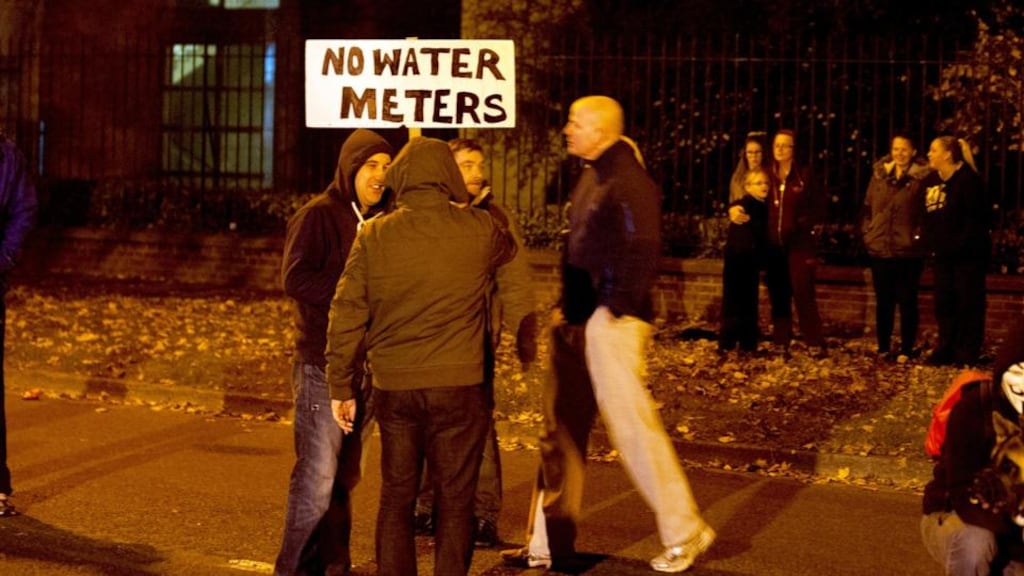Anti-water charge campaigners around the country have vowed to continue to block the installation of water meters despite a High Court order last week barring protesters from coming within 20 metres of workers.
The injunction granted to GMC Sierra, one of four companies contracted to install the meters, focused attention on Dublin where recent demonstrations have been peppered with sporadic violence.
The company postponed the installation of meters after the demonstrations but contractors across the country have for months been experiencing difficulty trying to install meters in the face of local opposition.
Although Irish Water claims the metering programme is ahead of schedule – with about 476,000 meters installed to date and an end-of-year target of 450,000 – it admits contractors have been forced to leave some areas, unable to carry out their work.
“The protests have necessitated the temporary cessation of work in some instances and this has been unfortunate for the wider communities at these locations,” said Irish Water, adding that the demonstrations had mainly been “peaceful in nature”.
Protesters argue that instances in which contractors pull out of areas represent victories for local campaigns that have strengthened community ties.
In Galway, Dette McLoughlin from Right2Water said any differences between neighbours had been put aside in the face of a bigger challenge; in Cobh, Co Cork, chippers reportedly send food to local protest groups.
Residents there now get up before dawn to look out for contractors, said John Lonergan, who is involved in the campaign across the county. They have set up “phone trees” to send out a mass of text messages alerting residents when contractors have been spotted. Facebook and other online social media also play a major part in the campaign throughout the country. “It’s bringing communities together,” said Mr Lonergan. “It’s phenomenal to see the effect.”
Irish Water intends to install just under 1.1 million meters by 2016, covering most households in the country. One of the long-term benefits will be in “facilitating the speedy detection and repair of leaks”, the company said.
But campaigners say the opposition movement is continually gaining traction and getting stronger. “I’m shocked and blown away by the number of people who have contacted me,” said Donegal councillor Micheál Mac Giolla Easbuig (Ind), who has been involved in protests in the county. Like many others, he said the issue was the “straw that broke the camel’s back” after years of austerity.
After a standoff last Wednesday, contractors had “pulled out of west Donegal” and were yet to return, he said, adding that residents had also started parking their cars over stop valves to prevent workers accessing their water supply.
Mr Mac Giolla Easbuig said he would encourage people to defy the High Court ruling, saying it effectively made the protests redundant. “Twenty metres? Where does that give us the right to protest?”
Further south, in Galway, metering is yet to begin. Ms McLoughlin said this gave protesters there an advantage. “When the first meters were being installed people didn’t really have a strategy,” she said. “By now we’ve been able to learn from what has and hasn’t worked in other parts of the country.”
She said as soon as the notification letters started to arrive, Right2Water Galway would hold street meetings to establish whether residents want to block the meters or not. “It’s up to the residents,” said Ms McLoughlin, adding that their concerns take priority over the High Court injunction. “We will do whatever that estate or particular resident wants us to do.”
Campaigners were in the process of setting up their own communications system, to alert residents when contractors were in their area but insisted there would be “no intimidation of workers” and that “everything will be peaceful”.
Security has been to the fore of late amid violent scenes at Dublin protests and claims that republican dissidents have become involved in some areas of the capital.
Sinn Féin Dublin City councillor Séamas McGrattan said there had been a dissident element involved in some of the protests but he pointed to the large scale public demonstrations of recent weeks as evidence that the campaign was extremely popular.
He said protests in his area, around Cabra, had been peaceful. Contractors had been turned away from parts of the Swilly Road and Annamoe Drive “and they haven’t come back”. He said the main issue was not the metering but whether people paid. At this stage contractors were not getting involved in standoffs with protesters. If a resident did not want a meter installed, they made it known to the worker who then marked an ‘X’ on the pavement “and moved on to the next house”, Mr McGrattan said. “It’s just not worth the hassle.”
Areas where there has been a delay in installing meters
Sligo: Sea Road
Clare: Killaloe; Parteen; Meelock
Limerick: Westbury; Corbally; St Lawrence Park, Garryowen; Ballinacurra Gardens
Tipperary: Willow Park, Clonmel; Boherduff Heights, Clonmel; Thurles
Cork: Ashbrook Heights; Passage; Rushbrooke, Cobh; Ballyphehane; Togher
Waterford: Lisduggan
Dublin: Raheny; Cabra; Santry; Clondalkin; Kilbarrack, Ayrfield; Donoghmede
Kilkenny: Ferrybank
Carlow: John Sweeney Park
Louth: Fr Murray Park, Dundalk
Laois: Woodgrove housing estate, Portlaoise
Meters: How many have been installed and where
54,141: Northwest
49,997: West
50,646: Southwest
60,878: Northeast
51,611: Dublin city
72,819: Midlands
86,383: Co Dublin
49,360: Southeast











